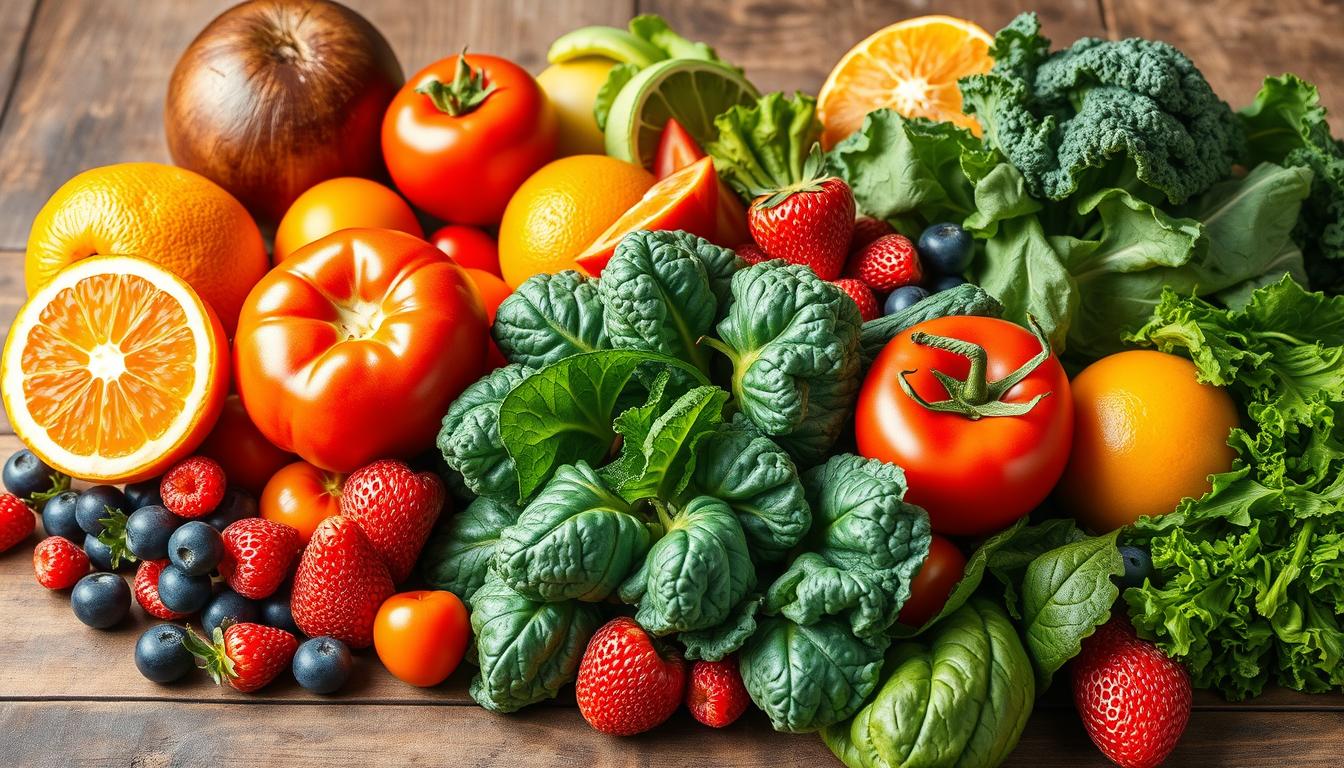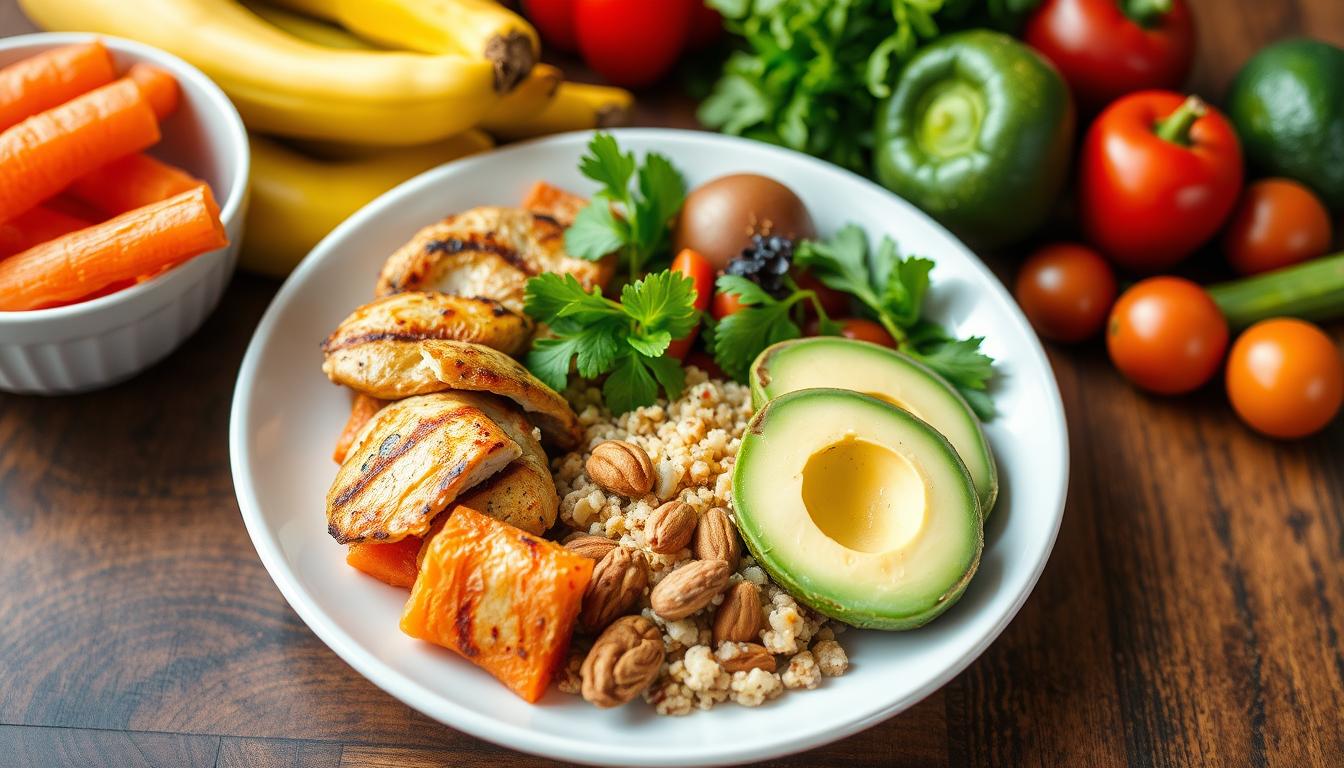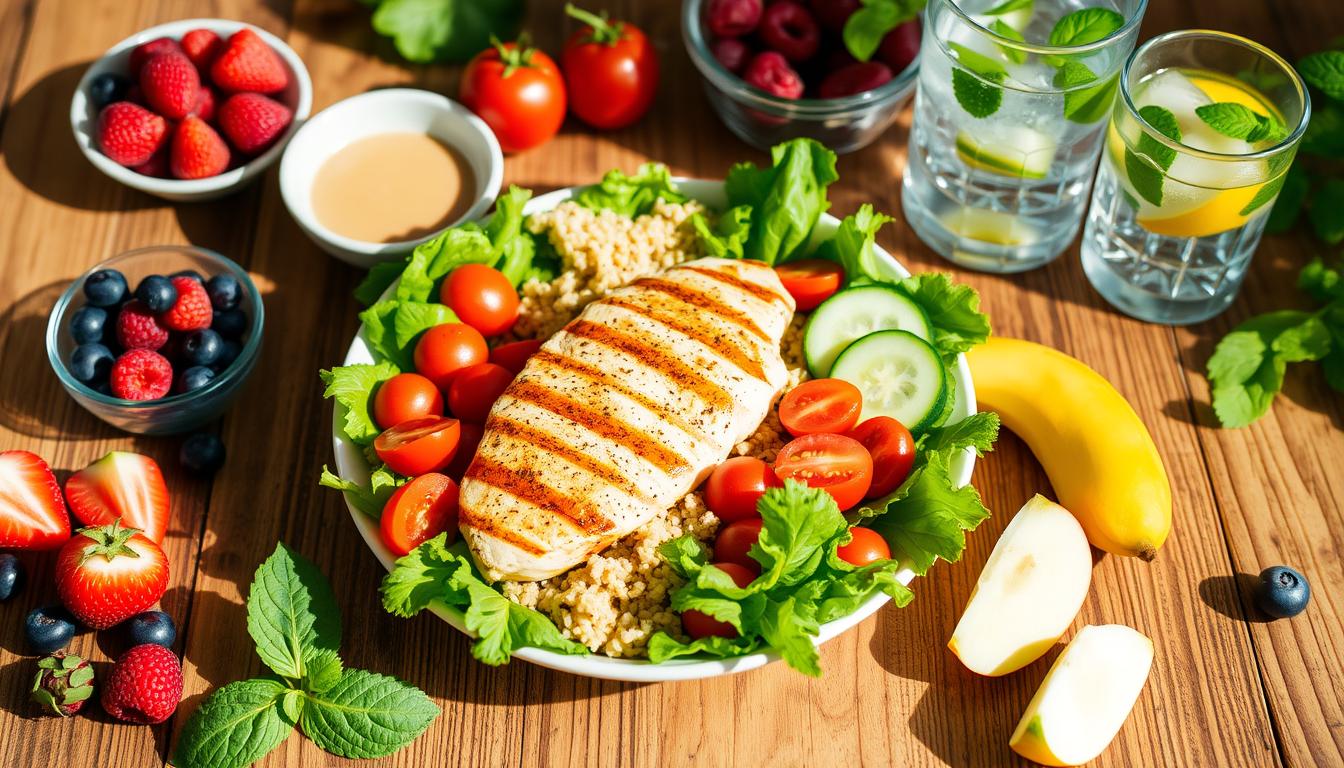Healthy eating is crucial for weight loss. Adding weight loss-friendly foods to your diet can be a game-changer. These foods are packed with nutrients, low in calories, and high in fiber. They are perfect for those trying to lose weight.
Eating a balanced diet with these foods can keep you full and satisfied. This reduces the chance of overeating. With the right mix of healthy eating and weight loss tips, you can reach your goals. Making smart food choices and staying committed will help you see results.
Introduction to Weight Loss
Knowing about weight loss-friendly foods is key to a healthy weight. Healthy eating and the best weight loss tips are essential. They help you control your weight loss journey and make lasting changes. With the right mindset and knowledge, you can overcome challenges and stay focused.
Understanding Weight Loss-Friendly Foods
To make smart food choices, it’s key to know what makes a food good for weight loss. Nutrition is a big part of this, as it affects our wellness. When we talk about losing weight, we often think about diet. But, it’s important to look at the nutritional value of what we eat.
A food that helps with weight loss gives us the nutrients we need without too many calories. This is where caloric density matters. Foods with low caloric density are more filling, which is great for losing weight. On the other hand, nutrient density is about how much good stuff a food has. Eating foods rich in nutrients helps us get the most from our diet and supports our wellness.
What Makes Food Weight Loss-Friendly?
Several things make a food good for weight loss. These include:
- High fiber content
- Low calorie count
- Rich in protein
- Low glycemic index
By adding these foods to our nutrition plan, we can help ourselves on our weight loss journey.
The Science Behind Satiety and Weight Loss
Understanding satiety is crucial for losing weight. Foods high in fiber and protein make us feel full, which helps us avoid eating too much. They take longer to digest, so we stay full longer. By choosing these foods in our diet, we help our weight loss efforts and improve our wellness.
High-Protein Foods for Weight Management
When it comes to weight loss, protein is key. Foods high in protein can help you feel full and reduce hunger. Some examples include:
- Lean meats like chicken and turkey
- Fish and seafood
- Eggs and dairy products
- Legumes like beans and lentils
- Nuts and seeds
Adding these high-protein foods to your diet supports fitness and health. Protein is crucial for muscle building and repair. It’s a must for a weight loss diet.
Remember, protein is more than just for muscle building. It boosts metabolism and fights hunger. A diet rich in protein helps you reach your weight loss goals and stay healthy.
Choosing the right foods and adding high-protein options to your diet is a great start. It leads to a healthier lifestyle that supports your fitness and weight loss goals.
| Food | Protein Content |
|---|---|
| Chicken breast | 31 grams per 3-ounce serving |
| Salmon | 20 grams per 3-ounce serving |
| Greek yogurt | 20 grams per 6-ounce serving |
Fiber-Rich Foods That Keep You Full
Fiber is key for a healthy digestive system and weight loss. Foods like whole grains, vegetables, and fruits keep you full. This helps prevent overeating.
Whole Grains and Their Benefits
Whole grains, like brown rice and whole-wheat bread, are full of fiber and nutrients. They help lower cholesterol, control blood sugar, and aid in weight management. Some whole grains include:
- Oats
- Barley
- Rye
Best Vegetables for Fiber Content
Vegetables like broccoli and carrots are packed with fiber. They also have vitamins, minerals, and antioxidants.
Fruits That Fight Hunger
Fruits, including apples and bananas, are high in fiber. They keep you full and are rich in vitamins and antioxidants.
Eating fiber-rich foods like whole grains, vegetables, and fruits is good for your health. It supports weight management and lowers disease risk.
| Fiber-Rich Food | Fiber Content (per serving) |
|---|---|
| Whole wheat bread | 3-4 grams |
| Broccoli | 5-6 grams |
| Apple | 4-5 grams |
Healthy Fats That Support Weight Loss
Many think all fats are bad for weight loss. But, healthy fats are key for nutrition and help with weight loss. Foods like nuts, seeds, avocados, and olive oil are full of nutrients. They keep you feeling full and satisfied.
Understanding healthy fats is important for your diet. They give you essential fatty acids for brain function and hormone production. They also help your body absorb vitamins and minerals better. Plus, they slow down carb digestion, which keeps blood sugar levels stable and makes you feel full.
- Avocados: rich in monounsaturated fats, avocados are a great source of healthy fats and fiber
- Nuts and seeds: almonds, walnuts, chia seeds, and flaxseeds are all high in healthy fats and protein
- Fatty fish: salmon, tuna, and mackerel are rich in omega-3 fatty acids, which can help reduce inflammation and support weight loss
Adding healthy fats to your diet can boost weight loss and nutrition. Focus on whole, unprocessed foods and healthy fats. This way, you can make a balanced diet that helps you reach your weight loss goals and improves your health.
Best Foods for Weight Loss: The Ultimate Guide
Choosing the right foods is key for weight loss. A good diet includes fruits, veggies, whole grains, and lean proteins. For breakfast, try oatmeal with fruit or scrambled eggs with whole-grain toast. These keep you full until lunch.
For lunch and dinner, pick lean proteins like chicken, fish, and turkey. Add roasted veggies and whole grains. Healthy snacks like fruits, nuts, and carrot sticks with hummus can also help. Some great foods for weight loss are:
- Leafy greens like spinach and kale
- Cruciferous veggies like broccoli and cauliflower
- Berries, citrus fruits, and apples
- Almonds, walnuts, and chia seeds
Drink lots of water all day. Aim for a diet full of different weight loss foods. This includes breakfasts like Greek yogurt with berries, lunches like grilled chicken salads, dinners like baked salmon with veggies, and snacks like protein smoothies.
Adding these foods to your diet can help you lose weight and stay healthy. Always talk to a healthcare pro or dietitian to make a meal plan that’s right for you.
| Meal | Weight Loss Foods |
|---|---|
| Breakfast | Oatmeal with fruit, scrambled eggs with whole-grain toast |
| Lunch | Grilled chicken salads, whole-grain wraps with lean turkey |
| Dinner | Baked salmon with roasted vegetables, quinoa with lean beef |
| Snacks | Fruits, nuts, carrot sticks with hummus |
Metabolism-Boosting Foods
For weight loss, a healthy metabolism is key. Certain foods can boost your metabolism, aiding your weight loss journey. These metabolism-boosting foods are easy to add to your daily meals.
Lean proteins, whole grains, and spicy foods are great examples. They can raise your metabolism and aid in weight loss. A healthy metabolism is vital for health and weight loss, helping those who want to improve theirs.
Here are some metabolism-boosting foods to try:
- Green tea, which can increase metabolism and aid in weight loss
- Lean proteins, like chicken and fish, which build muscle and boost metabolism
- Whole grains, such as brown rice and quinoa, which support a healthy metabolism
Adding these metabolism-boosting foods to your diet can greatly impact your weight loss journey. They help support a healthy metabolism, increasing your chances of reaching your weight loss goals.
Hydrating Foods for Weight Management
Drinking enough water is key for good health and can aid in weight loss. Foods with lots of water help keep you hydrated and give you important nutrients. Cucumbers, celery, and tomatoes are full of water and great for a diet focused on losing weight.
Fruits like watermelon, strawberries, and cantaloupe are also very hydrating. Besides these foods, drinking water, herbal tea, and low-sugar sports drinks can keep you hydrated. They also support your weight loss journey.
Water-Rich Vegetables
- Cucumbers: 96% water content
- Celery: 95% water content
- Tomatoes: 95% water content
Hydrating Fruits
- Watermelon: 92% water content
- Strawberries: 91% water content
- Cantaloupe: 90% water content
Eating hydrating foods can help with weight loss and overall health. Drinking water and herbal tea also helps with staying hydrated. They offer extra health benefits. By focusing on hydration and nutrient-rich foods, you can make a balanced diet that helps you reach your weight loss goals.
Foods to Avoid During Weight Loss
When you’re trying to lose weight, it’s not just about what you eat. It’s also about what you avoid. Some foods to avoid can slow down your progress. Knowing about nutrition is key to making smart diet choices.
Staying away from unhealthy foods is crucial for losing weight. Some foods to steer clear of include:
- Processed meats
- Sugary drinks
- Refined carbohydrates
These foods are full of calories, added sugars, and unhealthy fats. They can really hurt your weight loss efforts.
Instead of just thinking about what not to eat, focus on what you can eat. Eating a balanced diet with fruits, veggies, whole grains, and lean proteins can help. This way, you can stay on track and reach your goals. By making smart nutrition choices, you can succeed in losing weight and keep it off.
Remember, losing weight is more than just avoiding certain foods. It’s about adopting a healthy lifestyle. Combine a balanced diet with regular exercise and a positive attitude. This way, you can reach your weight loss goals and keep a healthy weight for years.
Meal Timing and Portion Control
When trying to lose weight, meal timing and portion control are key. Eating the right amount at the right time helps your metabolism and reduces hunger. This supports your weight loss goals.
Good meal timing and portion control lead to healthy eating habits. These habits are good for your body over time.
To lose weight successfully, meal timing matters a lot. Eating smaller meals often keeps your energy steady and stops overeating. Portion control is also crucial to avoid eating too many calories. By managing your portion sizes, you keep calorie intake healthy and support weight loss.
Best Times to Eat for Weight Loss
Eating at the right time boosts your metabolism and aids weight loss. Here are some tips:
- Eat a nutritious breakfast to kickstart your metabolism
- Have a balanced lunch to keep your energy stable
- Enjoy a light dinner for a good night’s sleep
Portion Size Guidelines
It’s important to control your portion sizes for a healthy calorie intake. Here are some tips to start:
- Use a food scale to measure your portions
- Eat slowly and stop when you’re full
- Avoid eating in front of screens or while distracted
By adding these meal timing and portion control tips to your daily routine, you’ll develop healthy eating habits. These habits will help you reach your weight loss goals and improve your overall health.
Smart Shopping Tips for Weight Loss Foods
Reaching your weight loss goals starts with smart shopping. Making the right choices at the grocery store helps you fuel your body well. It’s key to read nutrition labels carefully. Look for foods low in added sugars, salt, and unhealthy fats.
Here are some tips for smart shopping:
- Plan your meals and make a grocery list to avoid impulse buys
- Shop the perimeter of the store, where fresh produce and lean proteins are typically located
- Choose budget-friendly options like canned goods and frozen vegetables
Being mindful of your food choices can greatly impact your weight loss journey. Always check nutrition labels and pick budget-friendly options that fit your budget. With practice and patience, you can become a smart shopper and reach your weight loss goals.
“Healthy eating is not about depriving yourself, it’s about making informed choices that nourish your body and support your overall well-being.”
Follow these smart shopping tips and make simple changes to your daily habits. Focus on weight loss foods that are rich in nutrients but low in bad stuff. Get creative with budget-friendly meal prep and cooking at home.
Meal Prep Strategies for Success
Meal prep is key for weight loss success. It helps you eat the right foods for your body. This way, you can stay on track, even when life gets busy.
To succeed with meal prep, follow these tips:
- Plan your meals for the week ahead of time
- Shop for healthy ingredients and portion them out
- Prepare a variety of meals to keep things interesting
- Use containers that are easy to transport and reheat
Adding meal prep to your daily routine helps you reach your weight loss goals. Stay consistent, and don’t worry about small setbacks. With time, meal prep will be a big help in your journey.
Begin your meal prep journey today. It’s the first step to a healthier, happier you.
| Meal Prep Tip | Benefits |
|---|---|
| Plan your meals | Reduces food waste and saves time |
| Shop for healthy ingredients | Supports overall health and wellness |
| Prepare a variety of meals | Keeps meals interesting and prevents boredom |
Conclusion: Creating a Sustainable Weight Loss Diet
Learning about sustainable weight loss foods is key to lasting results. Focus on foods that are full of nutrients and keep you feeling full. This helps boost your metabolism and supports your wellness.
Don’t chase quick fixes. Sustainable weight loss is about making healthy choices for life. It’s a journey, not a race.
Start by planning your meals and controlling your portions. Try new recipes and make healthy foods fun. Remember, be patient and celebrate your small wins. Focus on how good you feel, not just the number on the scale.
Take control of your health with sustainable weight loss. You’ll be happier and healthier for it. Your body and mind will appreciate the effort.
FAQ
What makes a food weight loss-friendly?
Foods that help with weight loss are full of nutrients but low in calories. They make you feel full and satisfied. These foods have fewer calories but more nutrients per gram.
How do satiety and caloric density affect weight loss?
Feeling full is key for losing weight. It helps you eat fewer calories. Foods with fewer calories per gram are more filling and help manage weight.
What are some high-protein foods that can aid in weight loss?
Foods high in protein, like lean meats and eggs, keep you full. They also help keep your muscles strong while losing weight.
What are the benefits of incorporating fiber-rich foods into a weight loss diet?
Foods high in fiber, like whole grains and fruits, keep you full longer. This can lead to eating fewer calories and help with weight loss. Fiber also improves digestion and blood sugar control.
How can healthy fats support weight loss?
Healthy fats, found in avocados and nuts, make you feel full. They add important nutrients to your diet without adding too many calories.
What are some of the best foods for weight loss, and how can they be incorporated into meals?
Good foods for weight loss include lean proteins and whole grains. Add fruits, vegetables, and healthy fats to your meals. Try chicken stir-fries, whole-grain bowls, and smoothies with fruits and greens.
How can metabolism-boosting foods aid in weight loss?
Foods like chili peppers and green tea can boost your metabolism. This can help burn more calories and support weight loss when combined with diet and exercise.
What are some hydrating foods that can support weight management?
Water-rich foods like cucumbers and watermelon help with hydration. So do unsweetened herbal teas. They support weight management by keeping you hydrated.
What foods should be avoided during weight loss, and why?
Avoid foods high in added sugars and unhealthy fats. This includes baked goods and sugary drinks. They offer too many calories without much nutrition.
How can meal timing and portion control support weight loss efforts?
Eating at regular times and watching portion sizes helps control hunger and calorie intake. This is key for losing weight. It also keeps your metabolism healthy.
What are some smart shopping tips for finding weight loss-friendly foods?
Read nutrition labels and look for affordable, whole foods. Avoid impulse buys. Focus on foods that are rich in nutrients to help your weight loss goals.
How can meal prepping strategies contribute to successful weight loss?
Meal prepping helps you stick to your weight loss plan. It gives you healthy options and prevents unhealthy choices. It’s a great way to stay on track.



